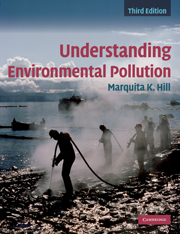Book contents
- Frontmatter
- Contents
- Preface
- Acknowledgements
- List of abbreviations and acronyms
- 1 Understanding pollution
- 2 Reducing risk, reducing pollution
- 3 Chemical toxicity
- 4 Chemical exposures and risk assessment
- 5 Air pollution
- 6 Acid deposition
- 7 Global climate change
- 8 Stratospheric ozone depletion
- 9 Water pollution
- 10 Drinking-water pollution
- 11 Solid waste
- 12 Hazardous waste
- 13 Energy
- 14 Persistent, bioaccumulative, and toxic
- 15 Metals
- 16 Pesticides
- 17 Pollution at home
- 18 Zero waste, zero emissions
- 19 Chemistry: some basic concepts
- Index
- References
9 - Water pollution
Published online by Cambridge University Press: 05 June 2012
- Frontmatter
- Contents
- Preface
- Acknowledgements
- List of abbreviations and acronyms
- 1 Understanding pollution
- 2 Reducing risk, reducing pollution
- 3 Chemical toxicity
- 4 Chemical exposures and risk assessment
- 5 Air pollution
- 6 Acid deposition
- 7 Global climate change
- 8 Stratospheric ozone depletion
- 9 Water pollution
- 10 Drinking-water pollution
- 11 Solid waste
- 12 Hazardous waste
- 13 Energy
- 14 Persistent, bioaccumulative, and toxic
- 15 Metals
- 16 Pesticides
- 17 Pollution at home
- 18 Zero waste, zero emissions
- 19 Chemistry: some basic concepts
- Index
- References
Summary
“The key to reducing dead zones will be to keep fertilizers on the land and out of the sea. For agricultural systems in general, methods need to be developed that close the nutrient cycle from soil to crop and back to agricultural soil.”
Robert J. Diaz and Rutger RosenbergWhether animal, plant, or microbe, water is essential to life. Fish and other water-dwelling creatures are vulnerable to polluted water and there are waters in the world so polluted that life has disappeared. In other locales fish and shellfish survive, but are not safe to eat because their flesh is contaminated. Humans enjoy being around water, but contamination with infectious organisms often makes swimming unsafe, and being near water with noxious odors or scum is not pleasant. Clean water – and enough of it – is vital. ▪ Laws governing water quality existed in the United States before 1972, but no uniform national law existed. Water pollution was not well controlled and some states, eager to keep or attract industry, were negligent. The Clean Water Act (CWA) of 1972 and the Safe Drinking Water Act (SDWA) of 1974 were laws mandating that water pollution be treated uniformly nationwide; they have been updated over the years. ▪ In developed countries, water bodies are generally cleaner. In the United States, some are much cleaner than in 1972, the year that Congress passed the CWA: in 1972, only 30% of US waters were judged fishable and swimmable. By 1994, it was greater than 60%.
- Type
- Chapter
- Information
- Understanding Environmental Pollution , pp. 236 - 285Publisher: Cambridge University PressPrint publication year: 2010
References
- 1
- Cited by

